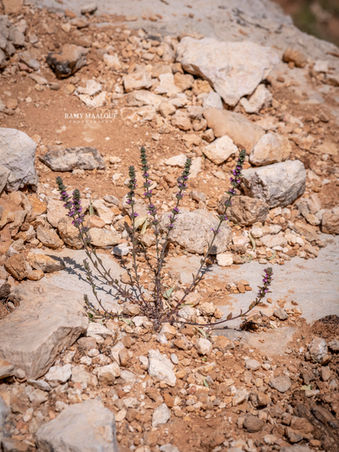Family |
Lamiaceae
Micromeria myrtifolia
Boiss. & Hohen.
Micromeria myrtifolia Boiss. & Hohen.
First published in Diagnoses Plantarum Orientalium 5: 19 (1844)
(Nouvelle Flore du Liban et de la Syrie, vol. 3, Pl. LXXXVIII nº 3; 1983)
• Life-form & habit: Perennial, very shortly pubescent–velvety herb 20–60 cm tall, with numerous erect stems arising from a lignified rhizome.
• Leaves: Lower leaves oblong to linear; upper leaves broader, ovate to oblong, spreading and slightly deflexed in the inflorescence; all leaves shortly pubescent.
• Inflorescence & flowers: Verticils dense, many-flowered, well-spaced and forming a long spiciform inflorescence. Floral leaves ovate and subacute. Calyx tubular, c. 2 mm, with subulate teeth; corolla pink, slightly exceeding the calyx.
• Fruit: Nutlets smooth (a generic character of Micromeria).
• Phenology: Flowers April – September.
• Habitat & elevation: Rocky places, old walls, and stony slopes; from hills to mid-mountain elevations.
• Lebanese distribution: Widespread and common. Recorded by Mouterde from Saïda, Beirut, Nahr el-Kelb, Tripoli, Kahalé, Chebaniyé, ʿAbey, Douma, Bsarma, Deir-el-Qamar, Bzoummar, Bhamdoun, ʿAchqout, Rayfoun, Broummana; also in Mount Lebanon (ʿAqoura, Bcharré, Hasroun, Barouk–Maʿasser, Qannoubine) and Anti-Lebanon (Rachaya), and extending into the northern and southern Beqaa (Deir-el-Ahmar–Mchaitiyé, Zahlé, Jdita, Ouadi el-ʿArayech, Yammouné).
• Native range: Cyprus, East Aegean Islands, Greece, Iran, Iraq, Kriti, Lebanon, Syria, Palestine, Sinai, Türkiye, Türkiye-in-Europe (POWO).
• ⚠️ Taxonomic note: Treated by Mouterde as Micromeria juliana var. myrtifolia. Distinguished by its multiflorous, compact verticils and its long, uninterrupted spiciform inflorescence, unlike the more lax, few-flowered verticils of M. juliana. Commonly used in herbal teas under the vernacular name zoufa.






